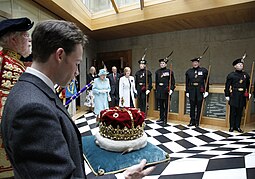| Honours of Scotland | |
|---|---|
 The Crown of Scotland at the Royal Opening of the Scottish Parliament in 2011 | |
| Overview | |
| Country | Scotland |
| Location | Crown Room at Edinburgh Castle |
| Size | 3 objects:
|
| Owner | Commissioners for the Keeping of the Regalia[1] |
| Managers | Historic Environment Scotland |
| Website | edinburghcastle.scot/honours |
The Honours of Scotland (Scots: Honours o Scotland,[2] Scottish Gaelic: Seudan a' Chrùin Albannaich),[3] informally known as the Scottish Crown Jewels, are the regalia that were worn by Scottish monarchs at their coronation. Kept in the Crown Room in Edinburgh Castle, they date from the 15th and 16th centuries, and are the oldest surviving set of crown jewels in the British Isles.[4]
The Honours were used together for the coronation of Scottish monarchs from Mary, Queen of Scots in 1543 until Charles II in 1651. From the Union of the Crowns in 1603 until the Union of 1707, the Honours were present at sittings of the Parliament of Scotland to signify the presence of the monarch and their acceptance of the power of Parliament. From at least the 16th century the monarch (or the Lord High Commissioner) signified the granting of Royal Assent by their touching the final printed copy of an Act of Parliament with the Sceptre during a meeting of the Parliament. Following the Union of 1707, the Honours were locked away in a chest in Edinburgh Castle and the Crown Jewels of England continued to be used by British monarchs as the Crown Jewels of the United Kingdom.[5] The Honours were rediscovered in 1818 and have been on public display at Edinburgh Castle ever since. The Honours have been used at state occasions including the visit of George IV in 1822, Elizabeth II's first visit to Scotland as monarch in 1953, and a national service of thanksgiving for Charles III following his coronation in 2023. The Crown of Scotland is present at each Opening Ceremony of the Scottish Parliament.
The Honours of Scotland consist of the Crown of Scotland, the Sceptre, and the Sword of State. The gold crown was made in Scotland and, in its present form, dates from 1540. The sword and sceptre were made in Italy as gifts to James IV from the pope. The Honours also appear on the crest of the Royal Coat of Arms of Scotland and on the Scottish version of the Royal Coat of Arms of the United Kingdom, where the red lion of the King of Scots is depicted wearing the crown and holding the sword and sceptre. Coronation robes, a pair of spurs, a ring and consort crowns were also part of the Scottish regalia, none of which survives today. The gold ampulla of Charles I that held anointing oil at his 1633 coronation now belongs to the National Museum of Scotland.
The Crown Room in Edinburgh Castle also contains the Elizabeth Sword, a silver-gilt wand, the 17th-century Stewart Jewels (which were added in 1830), and the Lorne Jewels, which were bequeathed to Scotland by Princess Louise, Duchess of Argyll, in 1939.
- ^ "Search results for controlling institution "Commissioners for the Keeping of the Regalia"". Historic Environment Scotland. Retrieved 31 August 2018.
- ^ "The Savin o Scotland's Honours (A Scottish Folk Tale) | Elphinstone Kist | Elphinstone Institute | The University of Aberdeen". www.abdn.ac.uk.
- ^ Das, Pooja (28 July 2022). "Na tha taobh a-staigh Caisteal Dhùn Èideann - feumar rudan tarraingeach den Chaisteal fhaicinn". Archived from the original on 11 November 2023. Retrieved 19 December 2022.
- ^ "The Honours of Scotland". Royal family. 15 January 2016. Retrieved 28 July 2021.
- ^ "The Honours of Scotland". Historic Environment Scotland. Retrieved 28 July 2021.